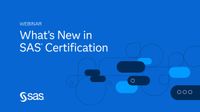- Home
- /
- Programming
- /
- SAS Procedures
- /
- How to lag by region, month, & year?
- RSS Feed
- Mark Topic as New
- Mark Topic as Read
- Float this Topic for Current User
- Bookmark
- Subscribe
- Mute
- Printer Friendly Page
- Mark as New
- Bookmark
- Subscribe
- Mute
- RSS Feed
- Permalink
- Report Inappropriate Content
Hello,
I am attempting to lag a variable by region, month, and year. Essentially, I need to create a new variable that is the lagged mean value (by year and month) for a neighboring region.
I have this:
region month year mean
1 1 00 5
1 2 00 6
1 3 00 4
1 1 01 4
1 2 01 5
1 3 01 5
2 1 00 4
2 2 00 5
2 3 00 3
2 1 01 3
2 2 01 5
2 3 01 2
and I need:
region month year mean neighbor_mean_lag
1 1 00 5 .
1 2 00 6 .
1 3 00 4 .
1 1 01 4 10
1 2 01 5 13
1 3 01 5 16
2 1 00 10 .
2 2 00 13 .
2 3 00 16 .
2 1 01 3 .
2 2 01 5 .
2 3 01 2 .
(Note neighbor_mean_lag equals the neighboring region's monthly values for the previous year.)
I am able to create a lagged variable for the same region using the below code. However, I haven't been successful at creating the lagged variable for a neighboring region.
DATA lag3;
SET lag2;
BY region month year;
lag1_mean=lag(mean);
if first.month and first.year then do;
lag1_mean=.;
end;
RUN;
Thank you for your help!
- Mark as New
- Bookmark
- Subscribe
- Mute
- RSS Feed
- Permalink
- Report Inappropriate Content
A self join will be simpler than using LAG
data have;
input region month year mean;
datalines;
1 1 00 5
1 2 00 6
1 3 00 4
1 1 01 4
1 2 01 5
1 3 01 5
2 1 00 4
2 2 00 5
2 3 00 3
2 1 01 3
2 2 01 5
2 3 01 2
;
data have1;
set have; by region notsorted;
reg + first.region;
run;
proc sql;
create table want as
select
a.region,
a.month,
a.year,
a.mean,
b.mean as neighbor_mean_lag
from
have1 as a left join
have1 as b
on b.reg = a.reg+1 and
b.year = a.year-1 and
b.month = a.month
order by a.reg, year, month;
quit;
- Mark as New
- Bookmark
- Subscribe
- Mute
- RSS Feed
- Permalink
- Report Inappropriate Content
looks like it is not a mean, it is a MEAN variable value for the next region. I would try Hash Table.
Ready to join fellow brilliant minds for the SAS Hackathon?
Build your skills. Make connections. Enjoy creative freedom. Maybe change the world. Registration is now open through August 30th. Visit the SAS Hackathon homepage.
Register today!Learn the difference between classical and Bayesian statistical approaches and see a few PROC examples to perform Bayesian analysis in this video.
Find more tutorials on the SAS Users YouTube channel.
 Click image to register for webinar
Click image to register for webinar
Classroom Training Available!
Select SAS Training centers are offering in-person courses. View upcoming courses for:



